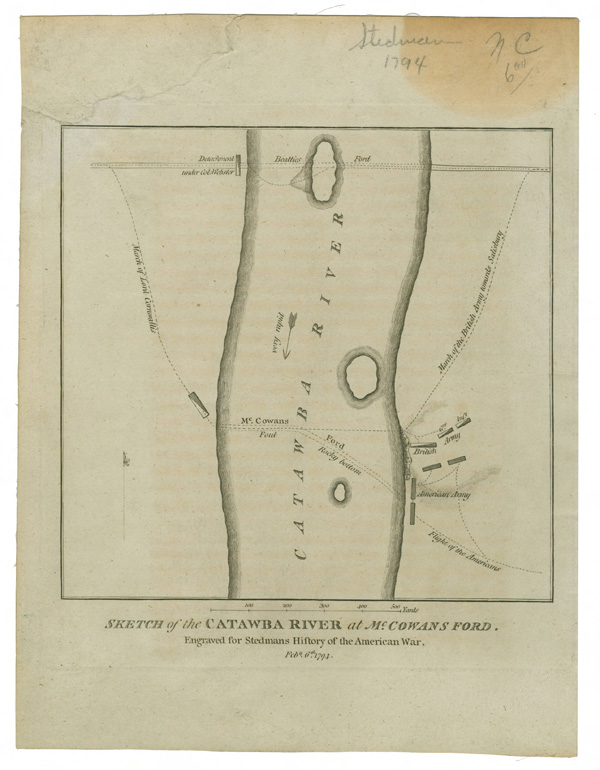

In February of 1781, Lord Charles Cornwallis, in pursuit of Nathanael Greene, engaged in a sharp fight at Cowan’s Ford on the Catawba River. The Battle of Cowan’s Ford claimed the life of North Carolina militia commander General William Lee Davidson, name sake of Davidson College, the town of Davidson, and Davidson County, NC.
The essay below, describing the battle in more detail, is quoted from North Carolina Office of Archives & History’s “Battle of Cowan’s Ford Essay,” available at http://www.ncmarkers.com/print_marker.aspx?id=L-22.
In February of 1781, Lord Charles Cornwallis, in pursuit of Nathanael Greene, engaged in a sharp fight at Cowan’s Ford on the Catawba River. Cornwallis and his army had made their way across Lincoln County, camping at Ramsour’s Mill before reaching the river. Cornwallis planned to cross at either Beattie’s Ford or Cowan’s Ford. Trying to deceive Greene, Cornwallis sent a portion of his troops to Beattie’s and marched the rest of his army towards Cowan’s. Greene anticipated that Cornwallis would attempt to hoodwink the Patriots and stationed General William Lee Davidson, along with roughly 500 militia from surrounding counties, at Cowan’s. A Tory named Hager led Cornwallis and his army through dense woods to the crossing.
The Catawba River was swollen by recent rains and consequently was roughly 400 yards wide. Cowan’s had two different fords, one for wagons and a shallower ford for horses. The wagon ford featured a rough river bottom with uncertain depths and a quick current while the horse ford proved more even flow and more shallow water, but it was a longer path. Both of the fords went into the river at the same place, but the ford for the wagons was a straight shot across the river while the horse ford veered right and crossed a small island, then traversed a rocky hill. Thinking that Cornwallis would cross his troops at the horse ford, Davidson camped with the bulk of his men approximately 200 yards away.
Upon seeing the lights of the campfires at the horse ford, Cornwallis, at around 1 o’clock in the morning, marched his troops through the wagon ford, ordering them not to fire until they had safely reached the opposite bank of the river. There was a volley of fire from the Whigs. Davidson, in an attempt to rally his troops, rode to the bank of the wagon ford where he was killed by a shot to the chest. With their general lost, the patriots began to flee. North Carolina militiaman Robert Henry recalled being told “It’s time to run, Bob!” The Whigs that remained gathered after the battle a few miles north at Torrence’s Tavern.
The delay provided Greene with the opportunity to escape Cornwallis and plan his retreat across North Carolina. The skirmish between the Patriots and Cornwallis’s army proved successful for the British. Upon crossing the river, Cornwallis continued with his pursuit of Greene which led six weeks later to the Battle of Guilford Courthouse.
The original site of the Battle of Cowan’s Ford now lies under the waters of Lake Norman. A memorial to the battle and General William Lee Davidson is located across from McGuire Nuclear Station. The former Southern Power Company, now Duke Energy, broke ground for the lake on September 28, 1959. The lake was named for Norman Atwater Cocke, a former President of Duke Power, and covers roughly 32,500 acres.
Location: 35.4326, -80.9585
Sources:
North Carolina Office of Archives & History. nd. “Battle of Cowan’s Ford Essay.” Available: http://www.ncmarkers.com/print_marker.aspx?id=L-22
Jacobs, Cindy. 2008. Around Lake Norman. Arcadia Publishing.
http://www.cmstory.org/history/timeline/default.asp?tp=5&ev=65
